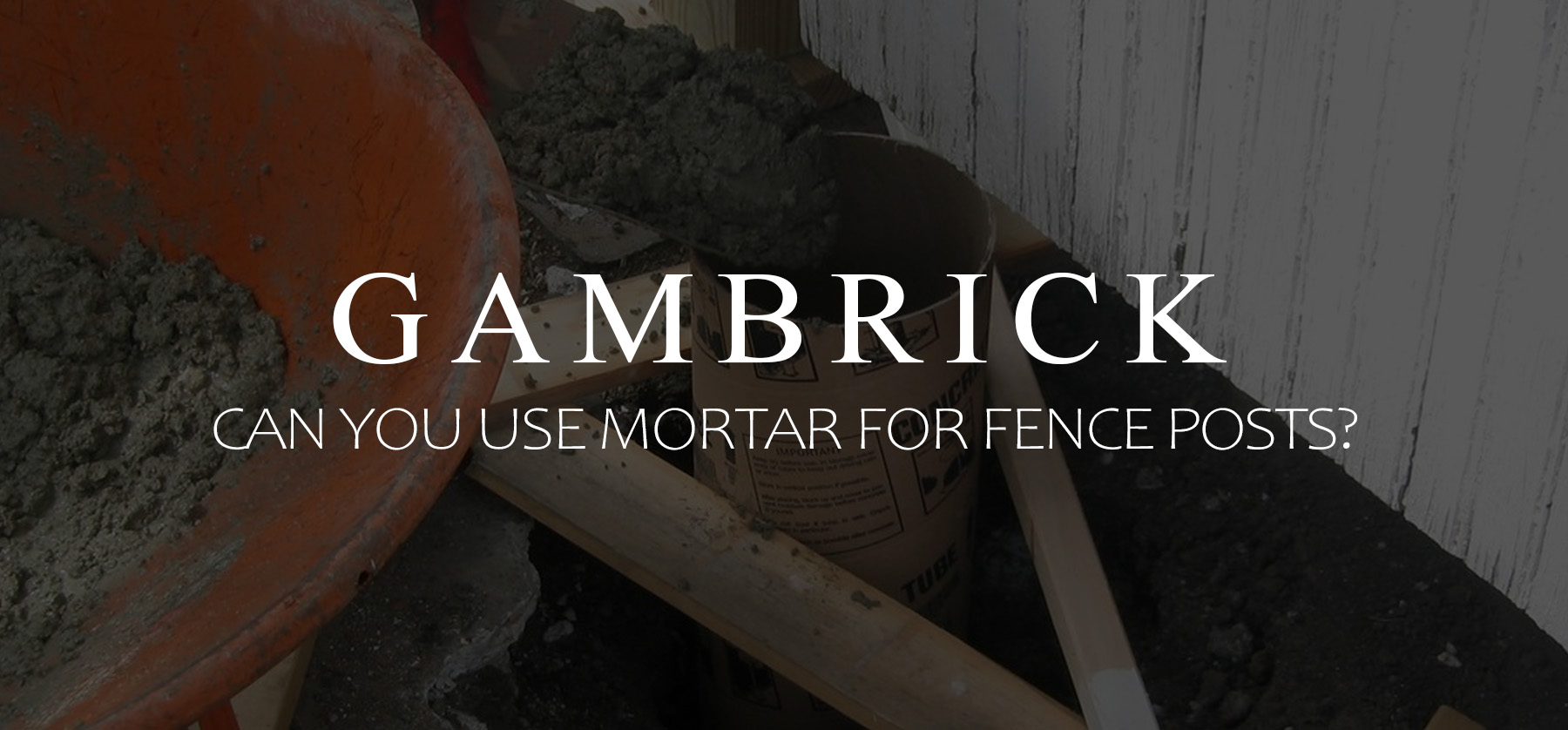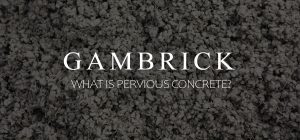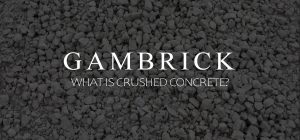Can You Use Mortar For Fence Posts?
Concrete and mortar are both used in a variety of building projects. They’re very similar products because both are made by mixing cement and sand with water, but there are some big differences. Concrete has stone aggregate and mortar doesn’t which means it’s heavier, stronger and more durable. The two products should not be interchanged or used as a substitute for the other. Concrete is stronger and more durable so it’s used for structural projects such as setting fence posts and building foundations, while mortar is used as a bonding agent for setting bricks and stones. But even though concrete is stronger, can you use mortar for fence posts?
Just because concrete is the better choice doesn’t mean you can’t use mortar to set a fence post. You can definitely set a fence post using mortar. Although the post won’t be as strong as if you used concrete, it’ll be stronger than just dirt or sand.
One of the problems with using large amounts of mortar is that it tends to crack. In general, mortar is used in small amounts to set stone or brick because it’s strong and sticky. It’s also a little more flexible that concrete. But in large amounts it’s prone to failure. However, when contained tightly in a hole or tube, it’s less likely to crack.
If you plan on using mortar to set your fence posts,I recommend mixing in a little stone. You can buy bags of it at any Home Depot or garden supply store. It’ll make the mortar heavier, stronger, more durable and less likely to crack. Essentially the stones with make mortar perform more like concrete.
Concrete Vs Mortar
Even though there are situations in which using mortar works great, concrete is almost always a superior material to use when setting fence posts.
Both concrete and mortar are a mixture of cement and sand mixed with water, but concrete also has stone. This makes it much stronger and more durable than sand and cement alone.
Because of the stone, concrete has a very high compressive strength, which means it can support a lot of weight without breaking. This makes it a great choice for building steps, sidewalks, driveways, foundations or to set fence posts.
Mortar does not have stone so it’s compressive strength is much lower. It tends to crack and break under heavy loads. However, if it’s contained tightly in a tube or the ground, there’s no where for it to crack. The mortar doesn’t bring much strength but it adds weight to the fence post which is better than dirt alone.
Both concrete and mortar come in pre-mixed bags which makes work easy. For setting fence posts I recommend Quikrete Fast Setting Concrete Mix. It sets up fast and dries to 4000 PSI at 28 days which makes it’s strong enough to support a fence.
One of the benefits to using mortar instead of concrete is that it’s lighter and easier to mix. This makes working easier. For some smaller fences concrete may be an overkill. If all you need is a little more strength than the dirt, throw in some mortar. I recommend adding a little gravel to the mortar as you pour it. Even just a little stone will add weight, strength and crack resistance.
Using Mortar To Set A Fence Post
If you decide to use mortar instead of concrete to set your fence posts there are a few things to consider.
- Weight. The weight of the fence will dictate how strong the posts need to be. In some cases mortar may be enough.
- Wind. Wind adds a lot of force to a fence. Especially if it’s solid.
- Style. Solid fences need a lot more support when it’s windy than fences with holes.
- Soil. Consider the soil conditions too. If your fence is in sand you may need the extra strength concrete provides.
Mortar is weaker than concrete, so if your fence needs a lot of support then choose concrete. But if the fence is light or has holes for wind to pass through then mortar may be strong enough.
Another situation where mortar may be enough is if your setting just a single post. This is especially true if it’s a replacement middle post of a long fence. The other posts,which are probably set in concrete, will provide additional strength. I wouldn’t recommend doing this if the single post is an end or corner because they carry more weight.
Vinyl and chain link fences are lighter than wood and steel so mortar may be strong enough to support them. In many cases these fences are set right in dirt, so the extra mortar can only help.
When setting a fence post with mortar, I recommend adding some small stones or gravel into the wet mix. Stones will add strength to the mortar and help it resist cracking.
You should also lay some gravel at the base of your post hole to provide an extra layer of support. This is very common whenever you pour footings.
What Is Mortar?
Mortar is a mixture of cement, usually Portland, sand and water. When mixed with water, it becomes sticky which makes it great at bonding two pieces of masonry together. If you have to stack bricks, stick on stone or set tile, mortar is what you should use.
Because mortar doesn’t have stone, it’s weaker than concrete and prone to cracking. There’s really no way to change this other than to add some stone. Most mortar has a strength of around 750 PSI (Pounds per square inch) after 28 days. By adding just a small amount of stone you can raise that to 1000 – 1500 PSI. That’s still less than the standard 4000 PSI strength concrete we generally use but it’s good enough for some applications, like setting posts for small fences.
Mortar has a higher water-to cement ratio than concrete. This gives it a thicker consistency which makes it a great bonding agent for brick and tile. When you use mortar to stack bricks, the mortar has to be strong enough to support the bricks above it. This is where a thick consistency can help.
What is Concrete?
Concrete is a mixture of cement, usually Portland, sand, stone and water. Basically it’s mortar with lots of stone added in. These stones provide lots of strength and durability. While mortar alone has a PSI of around 750, concrete can be over 5000. Even the standard mix of Quikrete is 3500 PSI which is over 4 times as strong as mortar.
When dry concrete is added to water and mixed, it turns into a semi-liquid state like oatmeal that can be poured into molds. It then hardens into a rock-like substance and retains the shape of the form it was poured into.
Concrete has a very high compressive strength and makes a great foundation material. If it wasn’t for concrete, pretty much all of the large scale buildings, damns and bridges would not be possible. It has more than enough strength and weight to set a fence post.
While you can set a fence post with mortar, I recommend using concrete is most cases. Using concrete will ensure that your fence remains strong for years.
| Material | Concrete | Mortar |
| Purpose | Durability, Strength | Binding Materials Together |
| Composition | Cement, Sand, Stone, Water | Cement, Sand, Water |
| Strength (After 28 days) | 4,000+ PSI | 750 PSI |
When Should You Use Mortar To Set A Fence Post?
In general, concrete works better for setting fence posts than mortar. However, there may be times where mortar is the better solution.
The main situation where you’d use mortar to set a fence post over concrete is if you just don’t need the additional strength. Mortar provides 750 PSI on it’s own, but you can easily get that to 1500 PSI by adding some stone. In some cases you just don’t need 4000. Concrete is very heavy and a lot of work. If all you need is an additional 1000 PSI then mortar may work just fine.
A rule of thumb I use is this, can the fence be installed in dirt alone? If the answer is yes then I typically use mortar because I want just a little more support. But if the answer is no then I definitely use concrete. If it’s a maybe then I have to make a judgement call based on the weight of the fence, the design and the soil conditions.
In very hard or rocky soil I’d probably go with mortar. But in sand I’d use concrete. If the fence was hollow, like chain link, I may use mortar. But if it’s solid and has to hold up to wind pressure, I’d use concrete.
I consider using mortar when I’m setting a fence post alone. Carrying all those 80 lb bags of concrete by myself is a lot of work.
Mortar is great for setting a single fence post. If you have to replace a middle post then mortar may provide enough strength since the other posts will add support too. I don’t recommend doing this if the replacement post is on an end or corner though. They sometimes carry more weight.
Wooden Fence Posts
One of the main problems with using wooden fence posts is their tendency to rot. This can be made even worse by using concrete and mortar. You can reduce the risk of rotting by using treated wood, wood that’s resistant to rot and draining the water away from the post, but there’s still a chance.
When temperatures fluctuate, the concrete and wood expand and contract. This creates a slight gap between the post and the concrete. This gap can fill with water which increases the chance of rot.To help with this I recommend sealing the gap with exterior flexible silicone. The silicone will help prevent water from getting between the wood and concrete.
If a post rots you’ll have to change it for a new one. This typically involves removing the post and all that heavy concrete. This is where mortar can be an advantage. Some fences just don’t need all that heavy concrete. If mortar is strong enough you should consider using it. It’s lighter and easier to change should you ever need to.
Steel Fence Posts
When it comes to setting steel, there’s really no substitute for concrete. Steel and concrete are what’s used to build just about every large scale modern structure you can think of. And that includes fences. However, if you’ve got a steel fence that’s light weight mortar may be an option. Just as with wood, I’d only use mortar if you don’t need that much extra strength.
If the fence can be supported by dirt alone, then mortar is what I’d use.
Vinyl Fence Posts
In general,vinyl fence posts are wrapped around a wood post which makes rotting an issue. But, if you’re using vinyl posts alone, you won’t have to worry about rot.
When setting vinyl fence posts in mortar watch out for wobbling. Vinyl is light so there’s not much weight anchoring the post into the footing. Over time, if the dirt isn’t strong or the posts aren’t deep, they can start to pitch.
Summary: Can You Use Mortar For Fence Posts?
Concrete and mortar are both used in a variety of building projects. They’re very similar products because both are made by mixing cement and sand with water, but there are some big differences. Concrete has stone aggregate and mortar doesn’t which means it’s heavier, stronger and more durable. The two products should not be interchanged or used as a substitute for the other. Concrete is stronger and more durable so it’s used for structural projects such as setting fence posts and building foundations, while mortar is used as a bonding agent for setting bricks and stones. But even though concrete is stronger, can you use mortar for fence posts?
Just because concrete is the better choice doesn’t mean you can’t use mortar to set a fence post. You can definitely set a fence post using mortar. Although the post won’t be as strong as if you used concrete, it’ll be stronger than just dirt or sand.
One of the problems with using large amounts of mortar is that it tends to crack. In general, mortar is used in small amounts to set stone or brick because it’s strong and sticky. It’s also a little more flexible that concrete. But in large amounts it’s prone to failure. However, when contained tightly in a hole or tube, it’s less likely to crack.
If you plan on using mortar to set your fence posts,I recommend mixing in a little stone. You can buy bags of it at any Home Depot or garden supply store. It’ll make the mortar heavier, stronger, more durable and less likely to crack. Essentially the stones with make mortar perform more like concrete.
If you have any questions or comments about recycling vinyl fencing Email any time.





















